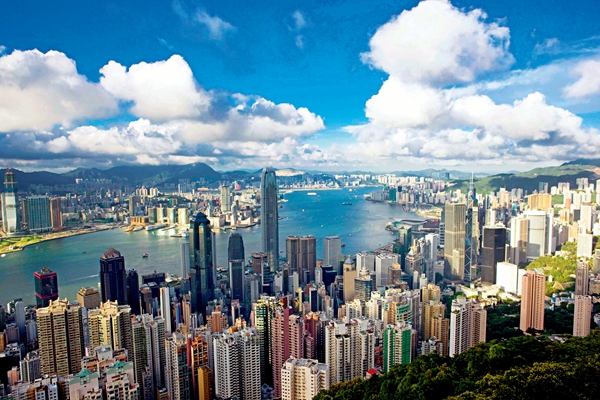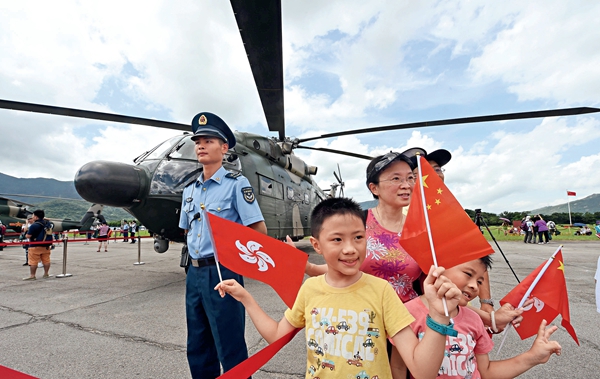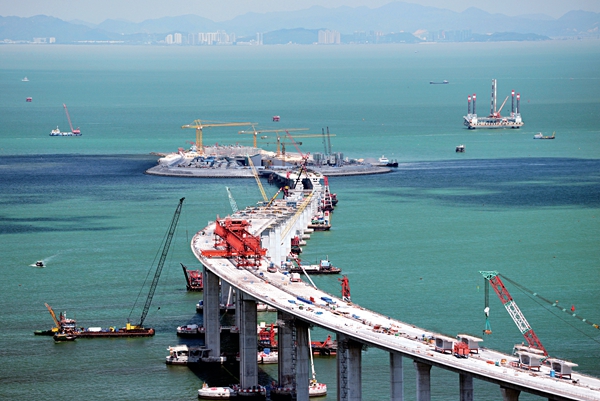By QI PENGFEI
By QI PENGFEI
DURING the two decades since its return to the motherland, Hong Kong Special Administrative Region (SAR) has withstood such serious tests as the outbreak of Severe Acute Respiratory Syndrome (SARS) in 2003, the 1997 Asian financial crisis, and the 2008 global financial crisis.
But, with great support from China’s central government and people in the mainland, the SAR government and seven million Hong Kong residents have developed a new model for continuous progress and long-term prosperity and stability by taking the advantage of the “one country, two systems” model while carrying forward the spirit of striving for success, standing together through adversity, and innovating and adapting to changes in a flexible way.
Unique Advantages
Making the best use of the region’s unique advant-ages is the key to the success of Hong Kong’s new model for economic progress.
In his policy address in 2005, the first chief executive of Hong Kong SAR, Tung Chee-hwa, pointed out that under the “one country, two systems” model, Hong Kong continued to be a highly liberal and diverse society that observes the rule of law.

Meanwhile, the region boasts a mature market economy, world-class infrastructure, a clean government, a highly professional and dedicated civil service, a simple tax system and low tax rate, good social and public order, and proximity to a vast and rapidly expanding market on China’s mainland.
Hong Kong is the only city in Asia endowed with all these advantages, which over time have given local industries a competitive edge, Tung said. His opinion is shared by Leung Chun-ying, the fourth chief executive, who has demonstrated that under the “one country, two systems” policy, Hong Kong has benefited from the strength of “one country” and the flexibility of “two systems.”
Rapid growth in the Chinese mainland and the favorable initiatives offered by the central authority enables the Hong Kong SAR government and the local community to make good use of the unique dual advantages of the policy, leverage local economic development to improve people’s livelihoods, and contribute to the country’s development.
Leung also observed that China is playing an increasingly prominent and leading role in the global economy. Against this background, Hong Kong’s dual advantages of “one country” and “two systems” and its role as “super-connector” are more apparent. The region enjoys boundless opportunities as it excels in offering what the country needs, he said.

The SAR government has launched two strategies – development of innovative technology and reindustrialization – to lift the local economy out of the financial downturn. These two strategies and their initial success have become key facets and new growth points for regional economic transformation.
Firm Support
Since its establishment, the Hong Kong SAR has withstood three severe shocks to its economy: the 1997 Asian financial crisis, the outbreak of SARS in 2003, and the 2008 financial crisis.
Faced with the Asian financial crisis, the central government and people on the mainland extended an immediate helping hand to Hong Kong and made every effort to maintain the region’s long-term prosperity and stability.
The SAR government received strong support in protecting its linked exchange rate system, and the RMB did not depreciate. This support from the central government enabled the SAR government’s swift measures to ensure the stability of its society and financial system.

In 2003, the SARS epidemic hit Hong Kong. It posed a serious threat to the lives and health of local residents, and dealt a further blow to the region’s economy which had not yet recovered from the Asian financial crisis. This led to a stock market slump, deflation and at 8.7 percent high unemployment.
Although the mainland also needed medical supplies in the fight against SARS, the central government provided a large quantity to Hong Kong free of charge. On June 29 of that year, the Mainland and Hong Kong Closer Economic Partnership Arrangement (CEPA) was signed. The agreement outlines the steps that the two sides should take with regard to trade in goods and services and investment, and the goals to be achieved.
Later, the Individual Visit Scheme was launched, allowing mainland residents to visit Hong Kong individually instead of having to travel under business visas or by joining group tours. These measures helped Hong Kong overcome the SARS epidemic and boosted its economic growth.
When the international financial crisis broke out in 2008, the central government introduced 14 policies covering seven sectors to ensure economic and financial stability in Hong Kong. Later, during their visits to the region, China’s state leaders announced more policies to support Hong Kong’s economic development, improve local people’s livelihoods and strengthen the region’s exchanges and cooperation with the mainland. All these policies played a positive role in boosting confidence, enhancing Hong Kong’s ability to defuse risks, and stimulating its economic recovery.
In addition, the central government firmly supports Hong Kong’s efforts to cement and advance its cutting edge and competitiveness as an international center of finance, trade and shipping. The central government also facilitates Hong Kong’s issuing of RMB bonds and trial RMB settlements in cross-border trade, thus consolidating Hong Kong’s position as a leading offshore RMB market. Furthermore, it has continued to encourage the listing of mainland enterprises on the stock market in Hong Kong, and introduced a great number of measures to stimulate the regional financial sector.
On top of that, the tourism and retail sectors in Hong Kong and Hong Kong-invested companies on the mainland have grown remarkably. At the request of the SAR government, the central government has gradually expanded the Individual Visit Scheme to 49 pilot cities on the mainland with a total population of over 300 million. By the end of September 2016, mainland residents had made 206 million trips to Hong Kong under the Individual Visit Scheme, accounting for 55.2 percent of the total number of mainlander visits to the region.
Over the last two decades, since its return to China, Hong Kong has always been one of the most important trading partners of the mainland, which has in turn been the largest trading partner of Hong Kong.
Economic cooperation has been carried out between Hong Kong and various mainland cities and regions, including nearby Shenzhen in Guangdong Province, and other parts of the Pan-Pearl River Delta region in a wide range of areas such as customs clearance, air traffic, large-scale infrastructure construction and environmental management.
With the CEPA now in force, the mainland levies a lower or even zero tariff on all products of Hong Kong origin. Today, barriers between Hong Kong and the mainland in logistics, investment, and flow of information and human resources are being removed as a broader range of cooperation is promoted, benefiting both sides with win-win outcomes.
However, Hong Kong’s economic recovery has been challenged by the generally unfavorable environment in the region and abroad. Whenever the SAR government asks for help, the central government – whole-heartedly backing Hong Kong’s bid to maintain its long-term prosperity and stability – guarantees an unlimited supply of basic necessities and raw materials.

Because of the restrictions of its natural environment, Hong Kong relies on the mainland for the supply of fresh water, vegetables, meat and other essentials. Since the early 1960s, when the mainland ran “three express trains” to supply the region with fresh and frozen goods and carried out the Dongjiang-Shenzhen water supply project, the central government and relevant local authorities on the mainland have made great efforts to ensure the supply of fresh water, foodstuffs, agricultural products, electricity, natural gas and so on.
In the last 20 years, the mainland has been playing a key role in supporting and ensuring Hong Kong’s economic development and social prosperity and stability. Having been brought into an institutionalized and normalized orbit, the “mainland factor” has been the buttress for the “one country, two systems” model.
Chinese President Xi Jinping has observed that since its return to China, Hong Kong’s future has been in the hands of its people and is linked more closely with the mainland. It is believed that with the firm support of the motherland and joint efforts of the SAR government and local people from all walks of life, Hong Kong can overcome any risks, difficulties and chall-enges. Tomorrow will be better for Hong Kong, and its residents will enjoy a better life. The Pearl of the East will shine even more brilliantly.
Worldwide Acknowledgement
Building a “new Hong Kong,” following the principle of “one country, two systems” has made remarkable achievements. In the last 20 years, the local economy has maintained sound and stable development with overall growth and a lower rate of unemployment.
Meanwhile, its key status in international finance, trade, and shipping has been further elevated. Maintaining its status as an international center of banking, an international securities market and an international foreign exchange market, Hong Kong has always been among the front-runners in terms of international banking and finance.
Moreover, this ninth-biggest economy of the world has regular trading ties with almost every country and is a major region worldwide. Hong Kong boasts one of the world’s largest container shipping ports and is a major ship register. Hong Kong International Airport is the world’s fifth-busiest international passenger airport and the most active air cargo terminal worldwide.
Besides, industries that have long been competitive and robust are continuously enhanced in Hong Kong. Trade and logistics, tourism, finance, and professional services and support services for industry and commerce continue to play an important role as Hong Kong’s pillar industries. What’s more, Hong Kong focuses on the development of culture, innovation, science and technology, testing and certification, as well as environmental protection industries.
The region has also maintained a sound business environment. For many years, it has featured prominently in World Bank rankings of the business environments of 185 economies. In its World Investment Report 2013, the United Nations Conference on Trade and Development ranked Hong Kong as third in the world in terms of attracting foreign direct investment.
The region has also been listed among the world’s most competitive economies for years in succession by the World Competitiveness Yearbook released by the International Institute for Management Development in Switzerland. It has been ranked as the world’s freest economy by the Washington-based Heritage Foundation for 23 successive years.
Meanwhile, according to the Cato Institute’s Human Freedom Index 2016, Hong Kong topped the list of 159 countries and regions for the sixth year in a row. The index was compiled using 79 distinct criteria such as rule of law and civil and economic freedom.
The outstanding economic performance of the “new Hong Kong” has been widely acknowledged by the international community, including those who did not relish the prospect of Hong Kong’s return to the motherland.
In the 1990s, Fortune magazine predicted a decline of the region in its article, “The Death of Hong Kong.” Nevertheless, 10 years after Hong Kong’s return to China, it admitted in a new article, “Oops! Hong Kong Is Hardly Dead,” so acknowledging that it had made a mistake.
On top of that, the last governor of Hong Kong, Chris Patten, has said that the “one country, two systems” model is working quite well in Hong Kong. The U.K. Foreign & Commonwealth Office has said that the British side believes that the “one country, two systems” policy is the best for Hong Kong’s long-term stability and prosperity. It also expressed hope that the model would always be respected and lead Hong Kong to greater success in the future.
A region with a high degree of openness and a “super-connector” between China’s mainland and the world, Hong Kong plays a significant role in the country’s opening-up strategies of “bringing in” and “going out,” according to Leung Chun-ying. Moreover, the region is ready to make full use of its advantages to contribute to the Belt and Road Initiative. With the successful implementation of the “one country, two systems” policy, Hong Kong is embracing a promising future.
QI PENGFEI, PhD in law, is director of the Taiwan, Hong Kong and Macao Research Center of Renmin University of China and vice chairman of the Chinese Association of Hong Kong and Macao Studies.